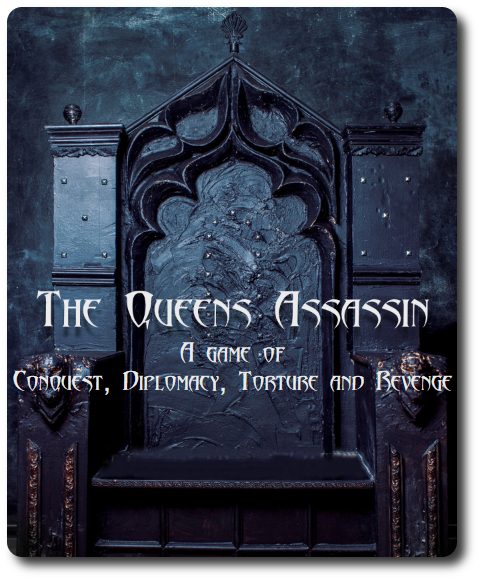
The Basics:
- For ages 8 and up (publisher suggests 12+)
- For 2 to 4 players
- Approximately 45 minutes to complete
Geeks Skills:
- Active Listening & Communication
- Counting & Math
- Logical & Critical Decision Making
- Reading
- Strategy & Tactics
- Hand/Resource Management
Learning Curve:
- Child – Easy
- Adult – Easy
Theme & Narrative:
- Lead your kingdom into battle and survive
Endorsements:
- Gamer Geek approved!
- Parent Geek approved!
- Child Geek approved!
Overview
You have ruled your kingdom wisely, but despite your best efforts, have never been able to secure your borders. Neighboring kingdoms seek to take over your lands and subjugate your people. Deciding you have had enough, you call for your Royal Assassin and task her to end the war. Thus begins the final confrontation for all the kingdoms.
The Queen’s Assassin, designed by Chet Kennedy, his children, and published by K5 Gaming via the Game Crafter, is comprised of 20 Character cards, 52 Game cards, 10 Special cards, and 4 Kingdom (player aid) cards. The cards are as thick and as durable as your standard playing cards. The illustrations are done by hand and range from slightly abstract to moderately detailed, enhancing the game’s thematic narrative.
Close the Gates!
To set up the game, first separate the Kingdom cards by color. Then place each Character card to its matching colored Kingdom card. There will be 5 Character cards per Kingdom card when done. Have each player select the color of their choice and taking all the Kingdom and Character cards. Place any unselected cards back in the game box.
Second, determine how many Characters will be used by all the players. Less Character cards makes for a shorter game. Have each player place the Character cards they want to use face-down in front of them. When all players have placed the determined number of Character cards, reveal them and place any unused Character cards back in the game box.
Third, have each character place their selected Character cards in front of them in a row. This row is referred to as the player’s “Castle”. Leave room below the Castle row for cards that will be placed in the player’s “Dungeon” row. The area above the player’s Castle is referred to as the “King’s Reach”. Players should also leave room directly to the right of the Castle row for a “Graveyard” pile.
Fourth, select any Special cards to be used in the game, setting any unused Special cards back in the game box. Shuffle both the selected Special and Game cards together. Deal 5 cards to each player, face-down. This is the player’s starting hand. Players should look at their hand, but keep their cards hidden until played.
Fifth, place the remaining deck of cards face-down in the middle of the playing area. This is the draw deck for the duration of the game. Leave room for a discard pile.
That’s it for game set up. Determine who will go first and begin.
A Brief Glimpse of Your Kingdom and Subjects
As ruler of the kingdom, you must know all there is to the land and its people if you are to protect them and your seat of power. The other kingdoms that border your own are looking to dethrone you and take all that you have worked so hard to obtain. Vigilance and knowledge will aid you in your upcoming battle.
The Kingdom
A player’s kingdom consists of three different areas.
The Castle and the Graveyard
The Castle row is the starting location of the player’s Character cards. From the Castle, the player will use their Character cards to order attacks and mount defenses. The Castle will stand, even if unused, until an opponent takes it over.
Outside of the Castle walls lies the Graveyard. Here the player will place captured Character cards that have been tortured.
The Dungeon
Below the player’s Castle row is the Dungeon row. Here players will place captured Character cards belonging to their opponents. Prisoners are sometimes kept safe for reasons of trade and others are tortured. It’s up to the player to decide what is best.
The King’s Reach
Beyond the kingdom’s boundaries lies neutral territory that each kingdom would like to own, but none can control. The King’s Reach is a lawless land, full of danger and hardship. Here murder is common place and the only goal is survival. Only the brave, foolish, and desperate venture into the King’s Reach.
The Characters
Each of the Character cards represents an influential and powerful member of the kingdom’s court. These people are a tremendous asset to the crown and also targets for the enemy. While within the protective walls of the Castle, they can help organize and orchestrate the kingdom. If they are captured or are wandering in the King’s Reach, the level of assistance they can provide is greatly reduced and might even be a determent to the kingdom.
The King
The “King” Character card gives the player a bonus when making decrees and offering bribes when safely behind the Castle walls. If captured and placed in an opponent’s Dungeon, the King has certain protection from harm, but not forever.
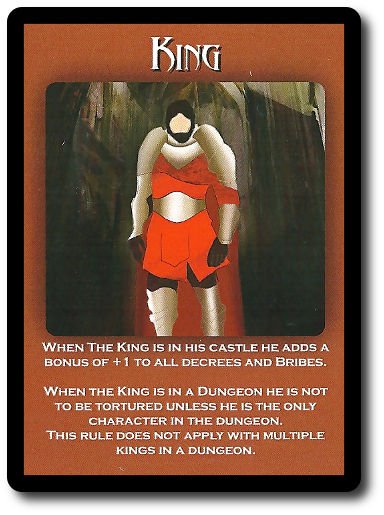
The Queen
The “Queen” Character card raises the morale of the troops protecting her in the Castle. Soldiers will bravely face dangers if they believe their Queen is at risk.
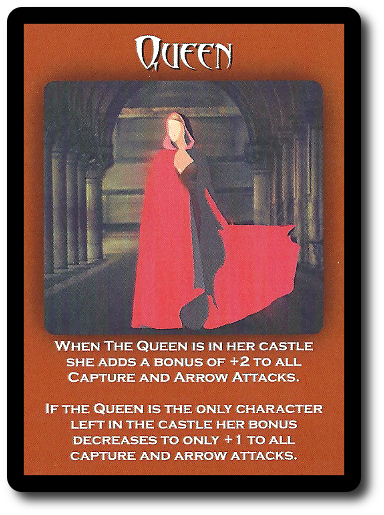
The Priest
The “Priest” Character card is knowledgeable in the art of healing and making medicine. While in the Castle, the Priest will help heal the wounded and remove sickness. The Priest also has a certain level of protection in the King’s Reach due to his religious status.
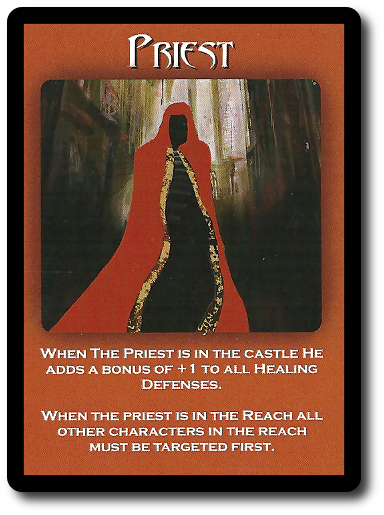
The General
The “General” Character card is a tacticians and gives a bonus to actions that require strategy and timing. The General is also as tough as nails. When captured and placed in an opponent’s Dungeon, torturing the General is anything but easy.
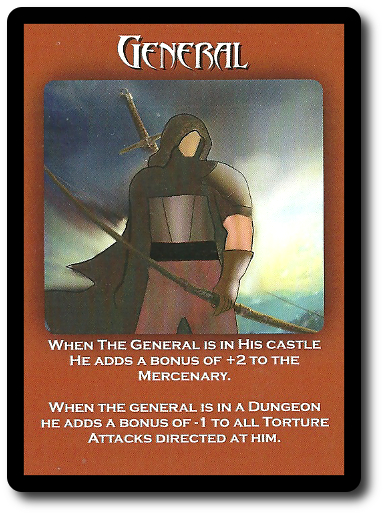
The Knight
The most loyal and skilled of the kingdom’s soldiers, the Knight will provide those in the Castle with extra protection from both enemy soldiers and assassins. The Knight lives to serve his King and will sacrifice himself to ensure his lord remains safe in the Castle.
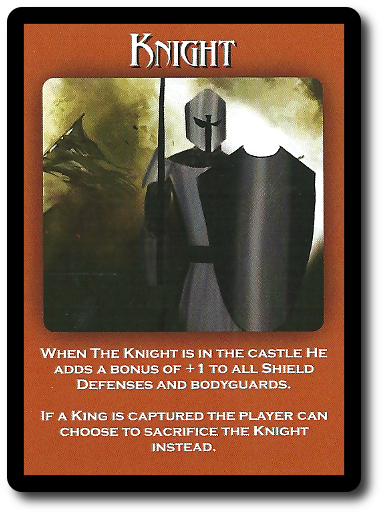
To War!
The Queen’s Assassin is played in turns with no set number of turns per game. A player can either play a card on their turn that allows them to take an action or discard. Not both. A player’s turn is summarized here.
Option A: Take Action
Actions are found on the grey, blue, green, and brown Game cards, as well as the Special cards. Unless otherwise stated, cards can only be played on the player’s turn. When a card is played, it’s immediately resolved, and then a new card is drawn from the draw deck to replace it. The available actions are summarized here and most cards provide up to 2 different actions each.
- Release an imprisoned Character card
- Bribe Dungeon jailers to keep a captured Character card safe
- Attack messengers delivering an opponent’s orders
- Attack bodyguards
- Torture captured Character cards in the Dungeon, sending them to the Graveyard
- Defend Character cards
- Outfit bodyguards with shields
- Rescue Character cards from the Reach
- Protect Character cards in the Reach
For example, the following card can be played as a defensive card within the Castle, used as healing in the Reach, or be used to mount a rescue mission to safely bring back a Character card lost in the Reach. All powerful and useful actions, but the player can only select one.
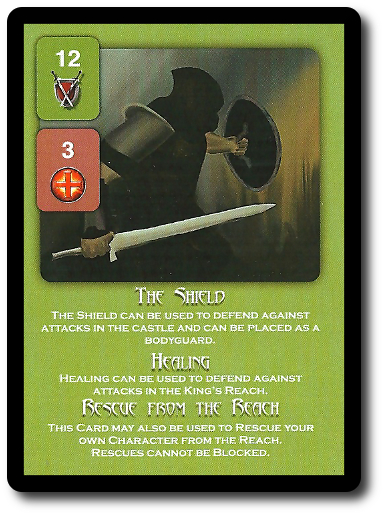
The Special cards, if any are used, can be played during this time, as well. Their use is described on the card’s face.
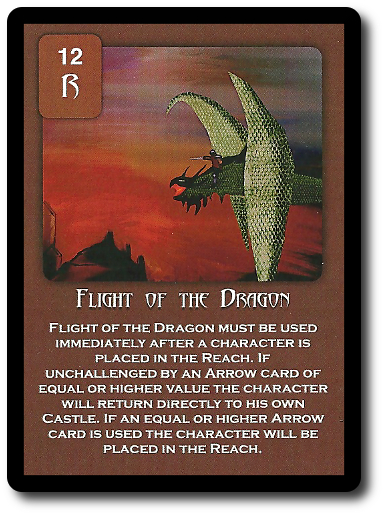
Option B: Discard
The other options the player can take on their turn is to discard a card in their hand for a new card. The player announces how many cards they are discarding and places that number in the Discard pile, face-down. The player then draws the same number of cards from the draw deck, placing them in their hand.
After completing either of the above options, the player’s turn is now over. The player must have at least 3 cards in their hand before game play can resume. The next player in turn order sequence now goes.
Defending and Attacking the Royals
Outcomes of actions are easy to determine by comparing number values associated with the action the active player is using and the defending player counters with (Ace always beats any number value). Almost each attack action has a counter defense action. For example, attacking a Character card with a Capture action can be countered with a Rescue action. Likewise, some actions can only target Character cards if they are in the right location or based on situational limitations.

In this way, a player should always attempt to keep Game cards that allow for a defensive actions, as these are played out-of-turn and in response to attacks from opponents. If the defending card’s number value is equal to or higher than the attack card’s number value, the Character card is safe. Once played, and regardless of the outcome, the Game card is discarded and a new one is drawn.
Alliances, albeit short and tentative at best, play a role in the game. Any opponent can attack another player, but they can also protect another player, as well. Help can be asked for and might be provided from the most unlikely of places for a price.
Death of a Monarch
Character cards are moved to the Graveyard if they are successfully tortured in the Dungeon area. If bribes and rescue attempts are unsuccessful, the fate of a captured Character card is not necessarily death, as it’s up to the player who has captured the Character cards to determine what should be done with them. Character cards can also meet their end by running into trouble in the King’s Reach.
When a player sends an opponent’s Character card to the Graveyard, their hand size increases by +1 for a maximum of 7 cards and the player who lost the Character card decreases their hand size by -1 for a minimum of 3 cards. In this way, a player’s hand (and strength) will fluctuate throughout the game.
The Last Kingdom
The game continues with each player taking turns, attacking their rivals, or desperately attempting to save their own Characters until only 1 player remains with living Characters cards. The number living is not important, nor is their location. If a turn ends and only 1 player has at least 1 living Character card in their Castle, in a rival’s Dungeon, or roaming the King’s Reach, they have won.
Game Variant
The game’s length can be adjusted by reducing or adding to the number of Character cards in play. Using all 5 Character cards will make for the longest game possible, while anything under 3 Character cards will make the game very short. I suggest you never go below 2 Character cards.
To learn more about The Queen’s Assassin, visit the game’s web page.
Final Word
The Child Geeks quickly learned the basics of the game and fumbled around longer than expected with the card play timing. It became obvious that the majority of Child Geeks were doing all they could to quickly go for the kill, which is both inefficient and leaves them open to attacks. This lesson was not learned until after the first game was completed. After that, the Child Geeks began to approach the game differently, subtly poking and prodding at their opponent’s defenses until they found a weakness. According to one Child Geek, “The best part of this game is working on ways to take out several kingdoms at once.” Most Child Geeks enjoyed the high level of smack talk involved in the game and few enjoyed having their Character cards sent to the Graveyard. As one Child Geek put it, “The worst feeling in the world is only being 1 turn away from saving your character, but not being able to do it in time.” When all the games were over, the Child Geeks decided they rather liked The Queen’s Assassin and voted to approve it.
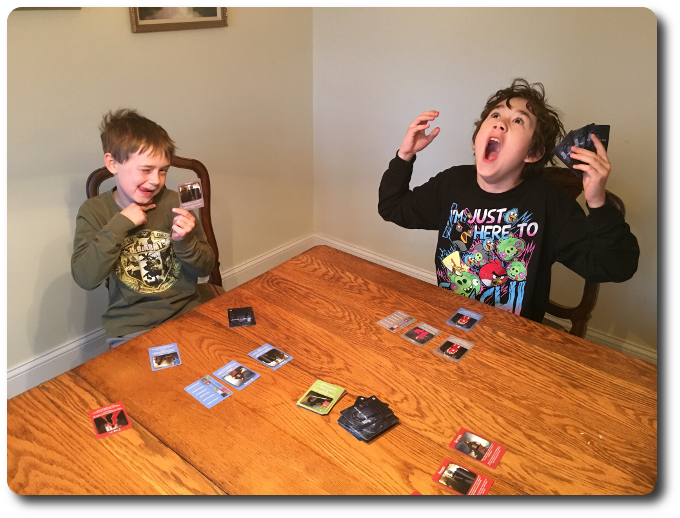
According to my oldest son, he would’ve rescued his Knight on his next turn. His younger brother went first.
The Parent Geeks were not fans of the term “torture” or the fact that the game used it to remove a Character card from play. There were a few Parent Geeks who didn’t feel comfortable playing the game with their kids as a result. For the others who had no problems (which represented the majority), they found the game to be easy to learn but surprisingly difficult to win. Some even suggested it was frustrating, but not in a way that was negative. One Parent Geek explained, “The game can be very frustrating because you just can’t seem to find the best possible moment to do what you want. You have to wait for your opening and that can feel like it takes forever sometimes.” If a player does wait for the “perfect moment”, they might wait longer than expected. The only opportunities in this game are those that the player makes and is gutsy enough to take action on. Another Parent Geek said, “I like how this game works. You have to watch your borders and the Reach, be both defensive and offensive, make friends and destroy enemies, and all the while watch what others are doing. I’m really enjoying it.” The interaction between the players was high, the table conversations were noisy, and the battles were bloody. When all the games were over, the Parent Geeks voted to approve The Queen’s Assassin.
The Gamer Geeks were pleasantly surprised by the game’s balance and high level of subtle tactics it required in order to compete and win. According to one Gamer Geek, “I thought at first this would be a game where you simply play a card and something happens, but everything in this game has a ripple effect. If I take on this player to my left, they might team up with the player on my right. You have to play politics and exploit weaknesses.” Another Gamer Geek said, “This game reminds me of The Game of Thrones. Everyone has an objective, everyone thinks they are right, and the only thing that matters is winning, as losing means oblivion.” While none of the Gamer Geeks found The Queen’s Assassin to have a lot of depth (sometimes the best choices were simply act and counter react), they did agree that the game was perfect as a filler and well worth playing. The Gamer Geeks approved The Queen’s Assassin.
The Queen’s Assassin is a light game that focuses first and foremost on timing. I liken the game play to a sword fight, where each thrust and parry must be executed flawlessly. Each attempt to complete an action gave me a giddy little thrill as I anxiously awaited a possible riposte from my opponents. The fact that any player can come to any other player’s aid makes it all the more possible to have your plans spoiled, but there are limitations to how much generosity one player can (or even should) show another.
Just about every card has a counter and no single card is so powerful as to turn the tide. A player wins this game by being the better player. Cards are random, but each card has 1 or more actions to chose from, making sure each player has a choice. And it’s for this reason I found the game to be so well-balanced. A player’s actions are not locked by their cards, but act as a means to an end. Not once did our players suggest they had nothing to do on their turn that was of value.
Some of the Parent Geeks were a bit squeamish when it came to the torturing and I can appreciate their point-of-view. However, I found it to be thematically accurate and exactly what the narrative called for. This is a game about survival, intrigue, and dark deeds. Doesn’t sound very family friendly, but it certainly is. Nothing is described in gruesome detail, no pictures illustrate flayed limbs or burning corpses.
As card games go, this is a good one. Simple to learn, easy to play, and difficult to win. Cards determine the outcome of the game, but it’s the players who are in control at all times. When you play, you are engaged with each player in an intriguing mix of passive aggressive game play and subterfuge. If you like card games where the objective is to survive, the balance is always maintained, and the real goal is to benefit from each and every opportunity, then do play The Queen’s Assassin.
This game was given to Father Geek as a review copy. Father Geek was not paid, bribed, wined, dined, or threatened in vain hopes of influencing this review. Such is the statuesque and legendary integrity of Father Geek.



